
An echinoderm is any member of the phylum Echinodermata. The adults are recognisable by their radial symmetry, and include starfish, brittle stars, sea urchins, sand dollars, and sea cucumbers, as well as the sea lilies or "stone lilies". Adult echinoderms are found on the sea bed at every ocean depth, from the intertidal zone to the abyssal zone. The phylum contains about 7,000 living species, making it the second-largest grouping of deuterostomes, after the chordates. Echinoderms are the largest entirely marine phylum. The first definitive echinoderms appeared near the start of the Cambrian.

Starfish or sea stars are star-shaped echinoderms belonging to the class Asteroidea. Common usage frequently finds these names being also applied to ophiuroids, which are correctly referred to as brittle stars or basket stars. Starfish are also known as asteroids due to being in the class Asteroidea. About 1,900 species of starfish occur on the seabed in all the world's oceans, from warm, tropical zones to frigid, polar regions. They are found from the intertidal zone down to abyssal depths, at 6,000 m (20,000 ft) below the surface.

A germ cell is any biological cell that gives rise to the gametes of an organism that reproduces sexually. In many animals, the germ cells originate in the primitive streak and migrate via the gut of an embryo to the developing gonads. There, they undergo meiosis, followed by cellular differentiation into mature gametes, either eggs or sperm. Unlike animals, plants do not have germ cells designated in early development. Instead, germ cells can arise from somatic cells in the adult, such as the floral meristem of flowering plants.

The Echinasteridae are a family of starfish in the monotypic order Spinulosida. The family includes eight genera and about 133 species found on the seabed in various habitats around the world.

Culcita novaeguineae is a species of starfish. It has short arms and an inflated appearance and resembles a pentagonal pincushion. It is variable in colour and can be found in tropical warm waters in the Indo-Pacific.

Culcita is a genus of cushion stars. They are found in tropical waters. Some are kept in home aquariums.

Psilaster andromeda is a species of starfish in the family Astropectinidae. It is native to the northeastern Atlantic Ocean where it occurs at abyssal depths.

Patiria miniata, the bat star, sea bat, webbed star, or broad-disk star, is a species of sea star in the family Asterinidae. It typically has five arms, with the center disk of the animal being much wider than the stubby arms are in length. Although the bat star usually has five arms, it sometimes has as many as nine. Bat stars occur in many colors, including green, purple, red, orange, yellow and brown, either mottled or solid. The bat star gets its name from the webbing between its arms, which is said to resemble a bat's wings.

Astropecten irregularis is a sea star of the family Astropectinidae. Common names include Sand sea star.
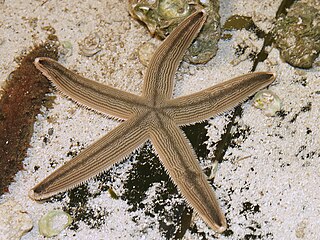
Luidia clathrata is a tropical species of starfish in the family Luidiidae. It is variously known as the slender-armed starfish, the gray sea star, or the lined sea star. It is found in the western Atlantic Ocean.
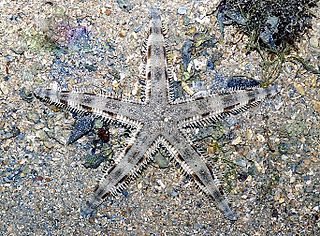
Archaster typicus is a species of starfish in the family Archasteridae. It is commonly known as the sand star or the sand sifting star but these names are also applied to starfish in the genus Astropecten. It is found in shallow waters in the Indo-Pacific region.

Asterias forbesi, commonly known as Forbes sea star, is a species of starfish in the family Asteriidae. It is found in shallow waters in the northwest Atlantic Ocean and the Caribbean Sea.

Evasterias troschelii is a species of starfish in the family Asteriidae. Its common names include the mottled star, false ochre sea star and Troschel's true star. It is found in Kamchatka and the north western coast of North America.
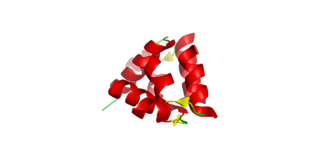
Relaxin family peptide hormones in humans are represented by 7 members: three relaxin-like (RLN) and four insulin-like (INSL) peptides. This subdivision into 2 classes is based primarily on early findings, and does not reflect the evolutionary origins or physiological differences between peptides. For example, it is known that the genes coding for RLN3 and INSL5 arose from one ancestral gene, and INSL3 shares origin with RLN2 and its multiple duplicates.

Astropecten scoparius is a sea star in the family Astropectinidae. It is found in shallow water in the East China Sea and around the coasts of Japan. It is a grey starfish and each of its five arms has a narrow pale margin. It burrows in the muddy sediments on the seabed and feeds on molluscs.
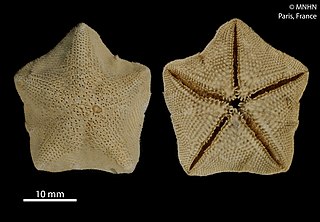
Cryptasterina pentagona is a species of starfish in the family Asterinidae. It is found in shallow waters in north eastern Australia. Its life cycle includes the release of large-yolked eggs and the development of planktonic larvae which is in contrast to the very similar Cryptasterina hystera which is viviparous. The two appear to have diverged from a common ancestral line only a few thousand years ago.
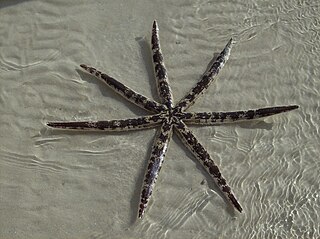
Luidia maculata is a species of starfish in the family Luidiidae in the order Paxillosida. It is native to the Indo-Pacific region. It is commonly known as the eight-armed sea star because, although the number of arms varies from five to nine, eight arms seems to be the most common.
Egg jelly is a gelatinous layer that surrounds the oocytes of many organisms and releases species-specific chemoattractants that activate and guide sperm to the oocyte. The release of chemoattractants is species dependent. For example, sperm in Lytechinus variegatus, the green sea urchin, are not chemotactically attracted to the jelly or the egg. The egg jelly is located immediately surrounding the vitelline envelope and consists primarily of a network of short peptides and sulfated fucan glycoproteins. These short peptides diffuse into the surrounding area and stimulate respiration and movement of the sperm to the egg. An example of such a peptide is resact, which has been studied as the primary means of attracting and orientating sperm to the eggs in sea urchins. The sulfated fucan glycoproteins play an important role in binding to sperm receptors and triggering the acrosomal reaction.
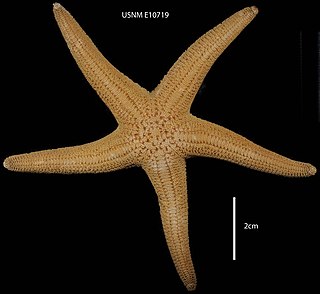
Stichaster striatus, the common light striated star, is a species of starfish in the family Stichasteridae, found in the southeastern Pacific Ocean. It was first described by the German zoologists Johannes Peter Müller and Franz Hermann Troschel in 1840.

Echinaster is a well-studied and common genus of starfish containing ~30 species and is the second-largest genus found within the family Echinasteridae. The genera Henricia and Echinaster encompass 90% of all the species found within the family Echinasteridae. It contains 30 species, however the number of species in this genus is still debatable because of uncertainty within the genera. This genus is currently sub-divided into two sub-genera: Echinaster and Othilia, evolutionary relationships between the sub-genera is not understood. Echinaster are found in the Pacific, Atlantic and Indian oceans, with most species being studied in the Gulf of Mexico and Brazil. The sub-genera Othilia is thought to encompass species mainly found in the Gulf of Mexico and Brazil. Echinaster is often one of the most studied species within the family Echinasteridae and is often used to find evolutionary relationships.



















